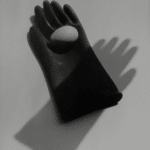-

Katsuji Fukuda
Still Life, 1954-55Vintage silver gelatin. Exhibition print.41 x 33.3 cmSigned, titled in pencil, date and various print date stamps on versoFurther images
Provenance
Property from the Jacobson/Hashimoto CollectionLiterature
Biography:
Katsuji Fukuda (1899 - 1991) was born in Yamaguchi Prefecture in south-western Japan. He moved to Tokyo in 1920, where he worked for the forerunner of Olympus (Takachiho Seisakujo). The Great Kantō Earthquake (1923) forced him to move to the Kansai region, where he held various positions including that of editorial assistant at Fuchikami Hakuyo’s famous magazine Hakuyo. He returned to Tokyo in 1933 where he turned to advertising photography and increasingly specialised in photographing women. Fukuda was a photographer who rapidly adapted his practise to embrace the technical developments which were revolutionising his field, and he published a number of technical treatise and dialogues which were regarded as highly influential by the following generation of photographers. In particular, Daidō Moriyama has described the importance of Fukuda’s imagery and approach at the time when he was reassessing the fundamentals of photography in his series Light and Dark (Hikari to Kage, 1982).
Fukuda’s life was celebrated at a solo retrospective held by the Yamaguchi Prefectural Museum of Art, and his works are held in the permanent collections of the National Museum of Modern Art, Tokyo, and the Yokohama Prefectural Museum of Art.

